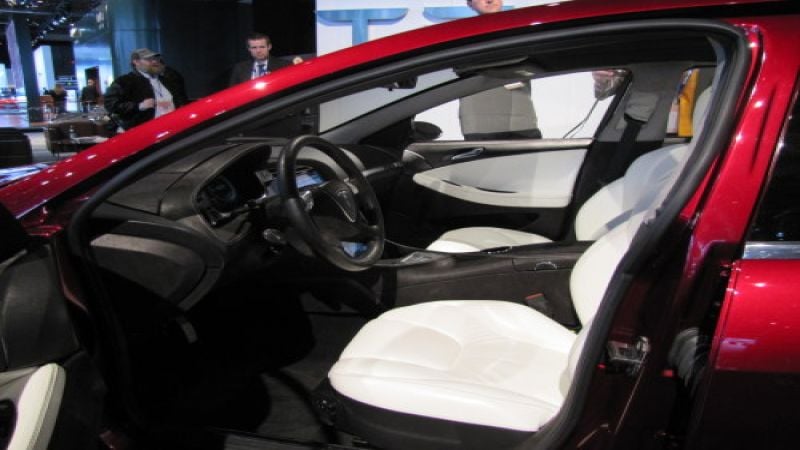For the record, electric power steering should not be confused with drive-by-wire or steer-by-wire systems which use electric motors for steering, but without any mechanical linkage to the steering wheel. The picture shows the steering and interior of the Tesla S model at NAIAS 2010.
Power steering assists have in the past been hydraulic, mounted in the engine compartment and away from the ears of the interior occupants. A pump powered by a belt and driven by the engine provided the pressure to move the hydraulic assist cylinders.
Some systems for larger vehicles use an electric motor to drive the pump. That is categorized as an electro-hydraulic servo motor.
With the advent of the full EV like a Tesla or a Nissan Leaf, there is no gasoline engine to drive the pump. And since the car is already fully electric, a full-electric steering unit makes sense from a system continuity point of view.
Even vehicles with the latest high-efficiency gasoline engines are now being replaced with electric power steering units. That high-volume usage helps reduce the cost of EPS units.
The real reason for the replacement of hydraulic units is fuel mileage related. The hydraulic pump steals horsepower from the engine, and that diminishes fuel economy.
There is change in design integration, though. My first experience with directly packaging around an electric power steering (EPS) unit came late in the first Chevy HHR program. It may have opened up space in the engine compartment, but it made packaging the wiring under the IP (instrument panel) a bit more difficult. Then came the ultimate reality: Those first EPS units were a bit noisy by comparison. So, considerable effort went into reducing the noise at the component level of the EPS unit itself.
Now, the latest EPS units are no longer particularly noisy, until you place them into the super quiet interior of an electric vehicle. Fact is, it’s amplified. The high frequencies are difficult to mask, let alone the rubbing of every mechanical interface.
Enter Nexteer Automotive
According to an article at ev.sae.org , to help overcome this noise issue, Nexteer opted to manage unwanted sound by replacing a steel coupling with a new thermoplastic design. This design change for its column-mounted EPS is going to pay off.
Nexteer Automotive development of this lightweight, flexible plastic coupling as an alternative to a steel type already has buyer. According to the article, it will be used on the forthcoming Citroën DS3.
Functional features of the new design include a system of flexible, ribbed pads that connect and transfer torque from one rotating shaft to another. The coupling stretches and compresses to allow variation within its axial (stroking) movement to occur without affecting radial or turning performance, which is experienced and interpreted by the driver as steering feel.
In fact, the new design coincidentally provides a fully compliant constant velocity (CV) joint, due to reduced friction. As a result, steering feel is reported to be improved.
Mass is also a big deal with EVs. So, having the finished part weigh in approximately 17% lighter than its steel equivalent obviously makes the vehicle integrator happy, and it comes with 50% cost savings, too, which adds to the bottom line. That reads like a win-win if there ever was one.
For the record, Nexteer Automotive was a pioneer of EPS systems more than a decade ago; and now production has now topped 12 million units.










